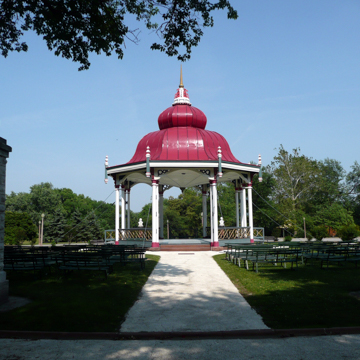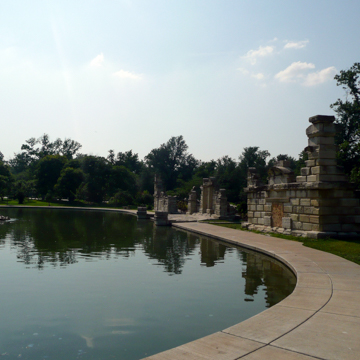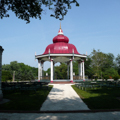In 1867, Henry Shaw donated 289 acres to the City of St. Louis for the establishment of a public park. Located adjacent to Shaw’s country estate and the 79-acre Missouri Botanical Garden to the north, in what is now south-central St. Louis, the prairie land was initially outside city limits.
The rectangular park is arranged around a series of drives and pathways that are mostly flat in elevation. The eastern park entrance, on Grand Avenue, leads to an east-west central drive with two ellipses and a roundabout, the latter of which is bisected by a north-south drive to the additional park entrances. The western portion of the part contains a sinuous loop drive. The roads were originally designed for horse-drawn carriages and later paved for automobiles, and there are various other pathways for strolling. Each of the four primary entrances accommodate motor vehicles and pedestrians, with each gateway flanked by tall monumental markers: at Grand Boulevard stand four stone piers, two of which are topped with zinc griffins and winged lions; at Magnolia Avenue are stone Gothic columns relocated from the Old Courthouse in what is now the Gateway Arch and Jefferson National Expansion Memorial; 40-foot octagonal towers with limestone battlements mark the Kingshighway entrance; and at Arsenal Street, eight rusticated piers support wrought-iron fencing outlining the semicircular entry. Additional wrought-iron and stone pedestrian-only gates dot the perimeter.
Tower Grove Park contains a diverse collection of thousands of trees and shrubs brought to St. Louis by Shaw and planted by James Gurney, Sr., an English gardener from the Royal Gardens at Kew, who would eventually become Tower Grove’s superintendent. Shaw aimed to present a staggering variety of exotic plant specimens to be enjoyed individually and as a collection. Such a practice of “botanizing,” he believed, would elevate the lives all those who encountered these plants, particularly St. Louis’s middle class, following the park’s opening in 1872. In an address to the Missouri Botanical Garden Society, the former Secretary of Agriculture Norman J. Colman agreed that such a park had a fine influence on families—that children whose families exposed them to contact with artful nature would go on to become better citizens.
To complement the Victorian gardenesque design of the park, local architects Eugene L. Greenleaf, Henry Thiele, and Francis Tunica designed a series of fanciful pavilions to serve as lawn ornaments and also to offer shelter from sun and rain. Most of these were completed by 1889. The Music Stand (1872), an eight-sided bandstand with a red, ogee-curved roof and bulbous dome surmounted by a tall finial, is one of the most well-known in the park. It is surrounded by six busts of European musical composers—one of the many examples of sculptural elements adorning the park. Just southeast of the Music Stand is Fountain Pond with its “ruins” comprising reassembled stone blocks and broken columns from the Lindell Hotel that once stood on the site. Shaw intended this as an ode to popular European estate follies that resembled ancient ruins. Other water features include the Lily Ponds, west of the Ruins, and a wading pool (1914, Ernst C. Janssen) flanked by playgrounds and located in front of the Roman Pavilion. Additional European influence can be seen in the Piper Palm House (1878) by George I. Barnett, whose design to house a collection of tropical plants was modeled on London’s Kensington Palace Orangery. The Palm House fell into disuse and later was used as a storage shed, but was restored in 1992 and rededicated to plant keeping. Shaw also commissioned artist Ferdinand von Miller to create three, monumental bronze statues of William Shakespeare, Alexander von Humboldt, and Christopher Columbus, which can be found at key points along the main drive.
At the time of Shaw’s death in 1889, gardenesque planting methods were falling out of public favor, with tastes shifting towards native species planting design and pastoral effects. Style aside, Tower Grove’s mission to educate and elevate the public remained relevant, anticipating the growing City Beautiful movement at the turn of the century. Improvements to visitor facilities and to sports and recreational amenities implemented by Superintendent Gurney balanced the cuts to botanic maintenance required due to the strain such a garden imposed on city budgets. In 1896, Olmsted, Olmsted and Eliot drafted an updated park plan but the contract was severed and plans were abandoned after disputes arose around the directives of Shaw’s will regarding the future of the gardens.
With a few modifications and additions over the years, Tower Grove Park continues to be a popular St. Louis attraction. Today it is an active site of recreation for joggers, cyclists, picnickers, tennis players, gamers, and bird watchers. It hosts numerous special events, festivals, concerts, movie nights, and farmers’ markets. The park’s trees provide crucial habitat for migrating birds, but these specimens are aging and in decline. The non-profit organization Friends of Tower Grove Park is raising money for a revitalization effort that would include reforestation and other special projects. The Board of Commissioners adopted a new masterplan for the park in 2017, which focuses on three main areas: renovating existing facilities for hospitality services; restoring the water bodies; and expanding open spaces around the Roman Pavilion for programming use and construction of contemporary facilities.
References
Colman, Norman J., et al. “Proceedings at the Second Annual Banquet to Gardeners, Florists and Nurserymen.” Missouri Botanical Garden Annual Report 1892.St. Louis: Missouri Botanical Garden Press, 1892.
Drabelle, Dennis. “Missouri Break.” Preservation: The Magazine of the National Trust for Historic Preservation 49, no. 5 (1997): 100-104.
Grove, Carol, and Library of American Landscape History. Henry Shaw's Victorian Landscapes: The Missouri Botanical Garden and Tower Grove Park. Amherst: University of Massachusetts Press, in Association with Library of American Landscape History, 2005.
Faherty, William Barnaby. Henry Shaw, His Life and Legacies. Columbia: University of Missouri Press, 1987.
Freeman, A. “Privately-Founded Park Filled with Charming Follies, and Another that was the Site of a Memorable Fair Tower-Grove-Park and Forest-Park St-Louis.” Architect 78, no. 4 (1989): 94-97.
Hamilton, Esley, “Tower Grove Park,” St. Louis, Missouri. National Register of Historic Places Inventory–Nomination Form, 1989. National Park Service, U.S. Department of the Interior, Washington, D.C.
"Our History." Tower Grove Park. Accessed March 24, 2021. https://www.towergrovepark.org/.
Sandweiss, Eric. St. Louis in the Century of Henry Shaw: A View beyond the Garden Wall. Columbia: University of Missouri Press, 2003.

















